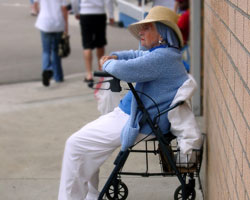Prevent Falls Among Seniors in Four Steps
A K-State aging specialist speaks on the dangers of falling and how older adults can protect themselves.
 August 28, 2015
August 28, 2015
MANHATTAN, Kan. – One of the most important reasons that falls among older adults are so dangerous is the high risk of serious injury. The National Council on Aging has declared Sept. 23 “Falls Prevention Awareness Day,” which aims to raise awareness about how to avoid these injuries.
“A lot of those (injuries) can occur to the brain, so we have a high incidence level of traumatic brain injury,” said Erin Yelland, adult development and aging specialist for K-State Research and Extension. “Also, a large proportion of older adults who fall experience injuries to their bones—hip fractures, wrist fractures, fractures to elbows and knees.”
Yelland said injuries from falls could take months and sometimes years to get over, especially if those injuries require surgery, often followed by physical therapy and rehabilitation. After falling once, many seniors experience a fear of falling again.
“Research has shown that a majority of the people who fall have a continued fear of falling,” Yelland said. “Programming called ‘Falling Less in Kansas’ aims to stop this fear of falling and gives people the tools to understand ways they can prevent falls.”
The Falling Less in Kansas program is a collaborative research effort among Wichita State University, Envision Low Vision Rehabilitation Center, the United Methodist Health Ministry Fund, the Harvey County Department on Aging, and the citizens of Harvey County, Kansas. K-State Research and Extension has adopted the program to serve local communities.
Yelland said the program offers seniors four main items to consider:
1. 1. Identify vision problems.
Yelland advises seniors to see their eye doctor at least once a year to make sure prescriptions are up to date, and to monitor for eye diseases or other problems.
“If your glasses are not the correct prescription, your vision is going to be off,” she said. “You’re not going to see as well as you normally would, which can lead to falls.”
2. 2. Make your home safer.
Installing devices in the home, such as grab bars, is a great safety precaution to prevent falls, Yelland said. These could be installed anywhere—along the walls of hallways, in the bathroom or next to the bed.
“When older adults start to lose their balance and grow wary of falling, they tend to lean toward the wall and walk along the wall,” she said. “If you’re in that stage, or you know someone who is, recommend that they install grab bars. So if they would fall, they could try their best to grab onto that bar and pull themselves back up to get to a telephone or to safety. The bars can also be a source of stability.”
3. 3. Assess your medications.
As people age, Yelland said, their doctors could place them on multiple medications. Seniors should visit their doctor and pharmacist to discuss their medicines and side effects.
“If a side effect is dizziness or disorientation, perhaps there’s a different drug you can take that has the same benefits but has less side effects,” she said. “Also, just being aware of what medicines you’re on and the side effects can prevent a lot of issues, including fall prevention, as older adults age.”
4. 4. Exercise to improve your strength, balance and mobility.
Yelland said exercise is a huge component of fall prevention: “Inactivity leads to weakness and an increased risk of falling. Through exercise that improves strength, balance and flexibility, we can increase the likelihood that our bodies are physically able to withstand a fall, help us recover from a fall, and more importantly, prevent falling. Also, with exercise often comes confidence and less fear of falling.”
She said Tai Chi, a low-impact martial arts, is a great way for seniors to exercise. Free instructional videos featuring this form of exercise are available online.
Using light weights, between 1 and 5 pounds, is also recommended to help build strength. If weights aren’t available, Yelland said seniors can do arm curls, wrist curls and arm lifts using canned goods from the pantry to build strength.
Go4Life Month
Also in September is Go4Life Month, sponsored by the National Institute on Aging at the National Institutes of Health. It calls to mind the need for seniors to be active in their daily lives to help improve their physical and mental well-being.
Yelland said engaging in simple activities each day will help keep seniors active longer and allows them to embrace aging. She challenges all seniors to take time this month and beyond to increase exercise to decrease their risk of falling.
For more information about preventing falls, contact your local extension office or visit the K-State Research and Extension website.
-30-
K-State Research and Extension is a short name for the Kansas State University Agricultural Experiment Station and Cooperative Extension Service, a program designed to generate and distribute useful knowledge for the well-being of Kansans. Supported by county, state, federal and private funds, the program has county Extension offices, experiment fields, area Extension offices and regional research centers statewide. Its headquarters is on the K-State campus, Manhattan.
Story by:
Katie Allen
K-State Research and Extension
785-532-1162
katielynn@ksu.edu
For more information:
Erin Yelland, 785-532-1905 or erinyelland@ksu.edu
